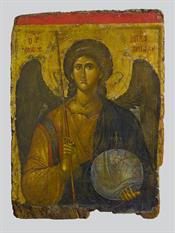THE PALAIOLOGAN PERIOD: THE FINAL FLOWERING OF BYZANTIUM BANNER
Description
Exhibition Space Text DescriptionThe final period of the Byzantine Εmpire owes its name to the dynasty of the Palaiologoi, the last and longest-lived dynasty of the empire. The Palaiologoi assumed the government of Byzantium in 1261, after the liberation of Constantinople, then held by Latins, by Michael VIII Palaiologos, and they continued to govern until the fall of Constantinople to the Ottoman Turks in 1453 – the decisive blow for the empire, which was a thousand years old but was now fragmented.
The dismemberment and weakening of the Byzantine state had begun much earlier, however. On all the borders, old and new enemies led inexorably to its geographical and economic contraction. Deprived of most of its territory, Byzantium retained as the name of empire only as a euphemism, since it was confined in essence to the area of Constantinople, the Despotate of Mystras and Thessaloniki. In the interior, as well, the dissolution of the central authority and administration, the weakening of the army, the ever increasing economic crisis and the dynastic and religious conflicts, led ineluctably to its collapse.
In contrast with the decline of the state, the arts, letters and sciences experienced a new flowering at this time, with the support of the Palaiologoi. It was a period at which there was a renewal of admiration for the great philosophers of the ancient world, as scholars studied and interpreted the ancient texts, thus preparing for the humanist renaissance of the 15th century.
Exhibits
-
 Archangel Michael
Icons and Wood-Carvings Ο ΑΡΧ(ΩΝ) ΜΙΧΑΗΛ Ο ΜΕΓΑC ΤΑΞΙΑΡΧΗ(C) (the Chief [among angels] Michael Grand Taxiarch) is depicted in a formal, frontal pose....
Archangel Michael
Icons and Wood-Carvings Ο ΑΡΧ(ΩΝ) ΜΙΧΑΗΛ Ο ΜΕΓΑC ΤΑΞΙΑΡΧΗ(C) (the Chief [among angels] Michael Grand Taxiarch) is depicted in a formal, frontal pose.... -
 Crucifixion
Icons and Wood-Carvings Double-sided icon: Side A: Crucifixion, Side B: Virgin and Child. The nobility and restrained sorrow characteristic of the sl...
Crucifixion
Icons and Wood-Carvings Double-sided icon: Side A: Crucifixion, Side B: Virgin and Child. The nobility and restrained sorrow characteristic of the sl...
Comments
Users must be registered and logged in to comment.
No comments found.